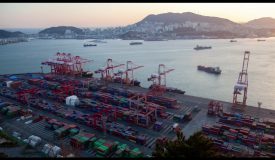Mobile City: Mall Travel
Director: Li Jiaxin
Mall is the epitome of mobile city. Mall, like a mobile city, has mobile vehicles to transport goods and people from different countries. There are great similarities between mobile cities and global cities (Oswin & Yeoh, 2010). Due to population migration, energy transportation and currency, global city can be called mobile city, but mobile city is not necessarily global city. In Stephen Baxter’s Flood (2009), there is a city named Walker City, its residents move frequently for the reason of global climate. In this situation, Walker City is a mobile city instead of a global city. Mobile city, just like its name, everything is moveable, including human beings.
After the outbreak of COVID-19, the traffic in physical shopping malls decreased. To reflect this phenomenon, video mainly adopts two methods. The first is the visual display method, which reflects the impact of the epidemic on the physical shopping malls by shooting the situation that there are no people in the shops and elevators in the physical shopping malls.
In addition, according to the development of the story, the flow of people did not increase. Shopping mall is empty both at the beginning and at the end. Secondly, by comparing physical shopping mall with online shopping mall, the differences between them under the epidemic situation are reflected. Both physical shopping malls and online shopping malls have goods from all over the world, and there is no difference between them in this feature. But in this comparison, cargo terminals and airplanes, constantly moving, are important places and tools for transporting. If goods are taken as reference points, the city is moving.
 This video is to show the changes of shopping malls in mobile city under the epidemic situation. Although the flow of people in physical shopping malls has decreased in COVID-19, the video shows that the number of customers in online shopping malls has increased, and the amount of goods is not much different from before, so it can be concluded that the number of movements in mobile city has not changed much under the epidemic situation.
This video is to show the changes of shopping malls in mobile city under the epidemic situation. Although the flow of people in physical shopping malls has decreased in COVID-19, the video shows that the number of customers in online shopping malls has increased, and the amount of goods is not much different from before, so it can be concluded that the number of movements in mobile city has not changed much under the epidemic situation.
In the video production process, the door opening sound is used to transition different scenes reasonably. The first door opening sound indicates going out to the mall, the second door opening sound indicates going home for online shopping, and the third door opening sound indicates opening the door to pick up the delivered express delivery. In addition, sunrise and darkness represent the passage of time.

In the video clip, slow motion is used for things that need to be highlighted, for example, the scene of the ascending elevator being empty and the shooting of buildings outside the store. Montage clips are used to photograph scenes in the store. The combination of fast lens and slow lens can fully show the current situation of the store.
Reference:
Oswin, N., & Yeoh, B. (2010). Introduction:Mobile city Singapore. Mobilities, 5(2), 167-175.
STORYBOARD:
1. Under the COVID-19 outbreak, in order to avoid the virus infection, people seldom go out except for the necessary work.
2. When the epidemic situation improved, I went to the mall on a sunny day. When I arrived at the mall, I found that there were very few people in the mall, which could be reflected in elevators and various shops.
3. In the process of shopping, I was bored, so I went home and turned on my computer to browse the online shopping mall.
4. There are many kinds of goods in the online shopping mall, and I can buy them by clicking them, so I bought several goods.
5. Next, I waited for the express delivery at home, and the express delivery was delivered to my home at night.
SCRIPT:


LI JIAXIN 3035795276
Hiiiii ! I appreciate the way how you’ve tried to visualize the film by not using any dialogues throughout the film, and the storyboard you’ve created is clear and beautiful, the overall message is clearly delivered. I believe that if the filming of the video could be more stable, that could be way better! Cuz it is a bit shaky.
It is creative that you looked into online ‘malls’ to discuss the impact of the pandemic on traditional malls in Hong Kong. Nonetheless, the contrast between the two is rather fragmented in the video. Why did you suddenly leave the mall and go back to visit Taobao? Is the first part of the video important to prove your point on mobility? The story line needs to be enhanced, e.g. the specific goods that you longed for is not available in the shopping mall due to the pandemic, then you seek it online. Moreover, mobility is not only about everything that moves. You have to select a focus for in-depth analysis. For example, if you are not allowed to move around the city/ around the world to get what you want, the online mall is able to help you with it. What is the potential issue if traditional malls are replaced by online malls? Right now, it seems only its benefits are discussed. A more critical and careful approach to the video is needed to bring more insights.